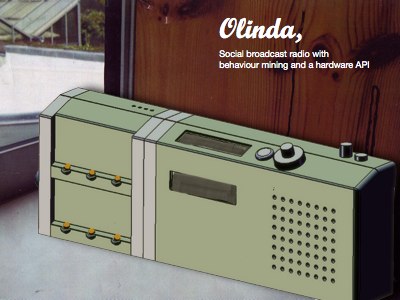Movement
This is Olinda, a radio prototype Schulze & Webb is currently building for the BBC.
Radio’s really big in the UK. A few years ago, in terms of hours listened per week, it overtook TV. There are about 70 broadcast digital channels, and those are what this radio tunes into. There’s no internet streaming radio here.
We wanted to take all the ideas that have been really successful on the Web, and see if we could apply them to consumer electronics… really take them mass market, you know.
So we started small. The first thing we did was ditch the idea of presets. Often people don’t bother programming those little buttons with the stations they want to listen to. Instead the radio monitors how you listen to it, and compiles a list of your most-listened-to stations instead.
Then what we did was stick a wifi card in the radio so you can share the fact you’re listening to the radio with your friends, using a social listening Web service already built by the BBC. On the left of this mock-up you can see six lights. When one of those comes on, you know that somebody in your primary network of friends and family is listening to the radio. So you press the light to see what they’re listening to, and if you like it then you tune in to listen along with them.
And finally the radio is modular. It hooks together with magnets. Between the modules are connections that anyone can plug into, and there’s an API so modules can subscribe to station change events, or provide an alternative control interface. We’ve been calling this a ‘hardware API’ and I think – in the future – all consumer electronics will come with one, just as an API is becoming a necessity for websites now.
Now the reason I’m showing you a mock-up is because the radio’s not finished yet. Currently it looks more like this…
